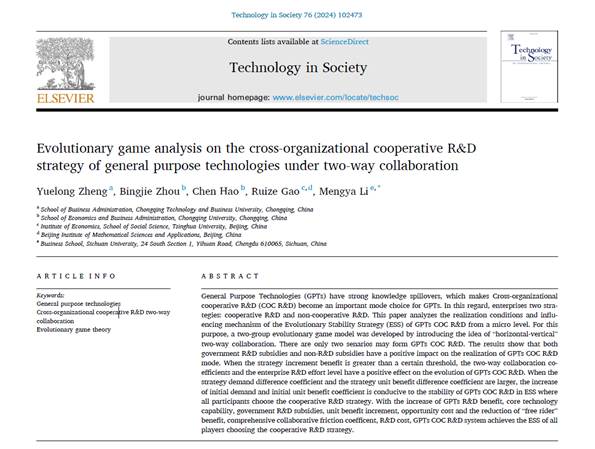【全文链接】
Zheng Y(郑月龙), Zhou B, Hao C, et al. Evolutionary game analysis on the cross-organizational cooperative R&D strategy of general purpose technologies under two-way collaboration[J]. Technology in Society, 2024: 102473.
https://doi.org/10.1016/j.techsoc.2024.102473
【第一作者】
郑月龙,bat365在线平台官方网站教授,研究方向为技术创新管理、博弈论及运用领域研究。
【论文摘要】
General Purpose Technologies (GPTs) have strong knowledge spillovers, which makes Cross-organizational cooperative R&D (COC R&D) become an important mode choice for GPTs. In this regard, enterprises two strategies: cooperative R&D and non-cooperative R&D. This paper analyzes the realization conditions and influencing mechanism of the Evolutionary Stability Strategy (ESS) of GPTs COC R&D from a micro level. For this purpose, a two-group evolutionary game model was developed by introducing the idea of “horizontal-vertical” two-way collaboration. There are only two senarios may form GPTs COC R&D. The results show that both government R&D subsidies and non-R&D subsidies have a positive impact on the realization of GPTs COC R&D mode. When the strategy increment benefit is greater than a certain threshold, the two-way collaboration coefficients and the enterprise R&D effort level have a positive effect on the evolution of GPTs COC R&D. When the strategy demand difference coefficient and the strategy unit benefit difference coefficient are larger, the increase of initial demand and initial unit benefit coefficient is conducive to the stability of GPTs COC R&D in ESS where all participants choose the cooperative R&D strategy. With the increase of GPTs R&D benefit, core technology capability, government R&D subsidies, unit benefit increment, opportunity cost and the reduction of “free rider” benefit, comprehensive collaborative friction coefficent, R&D cost, GPTs COC R&D system achieves the ESS of all players choosing the cooperative R&D strategy.
